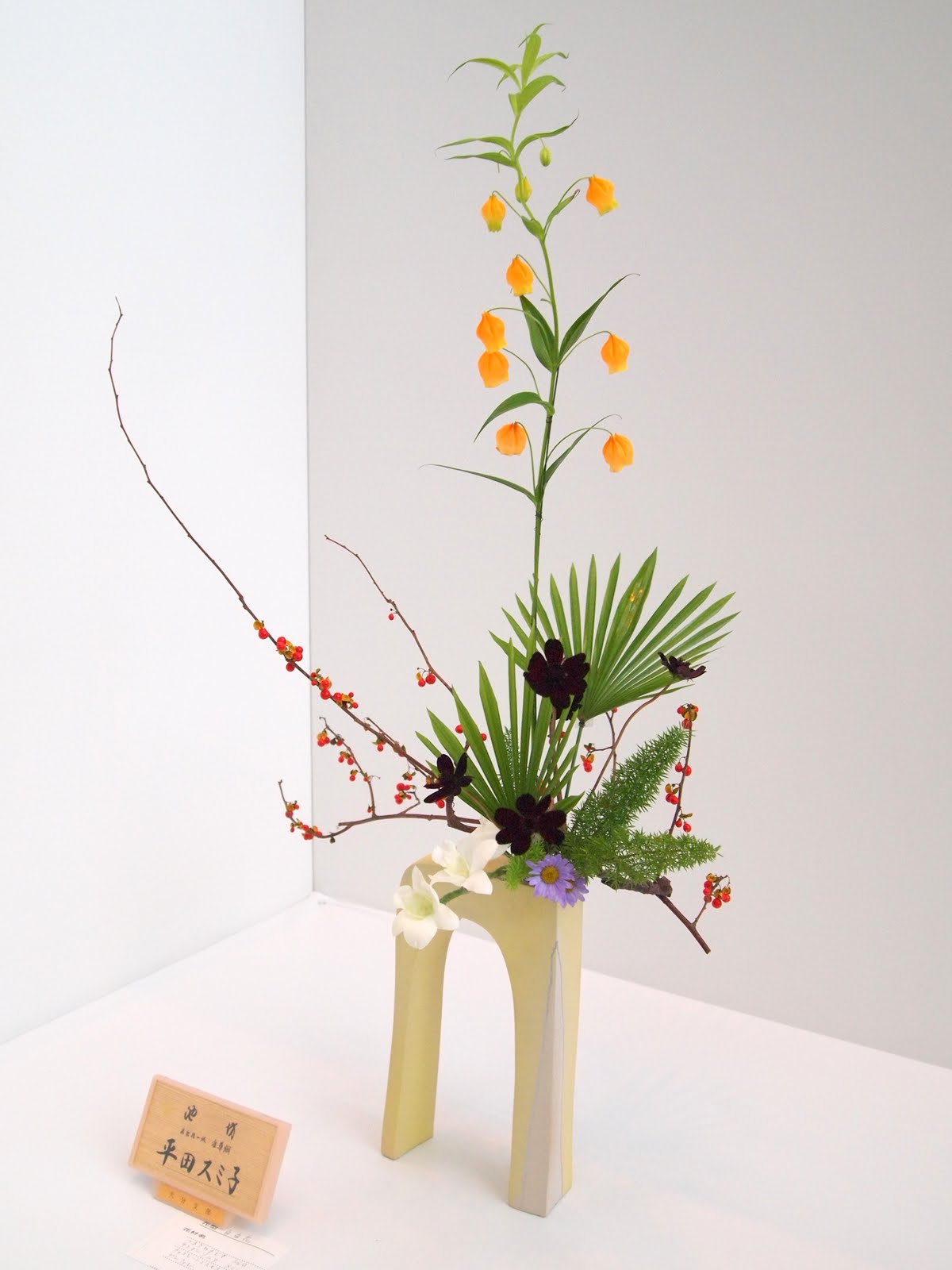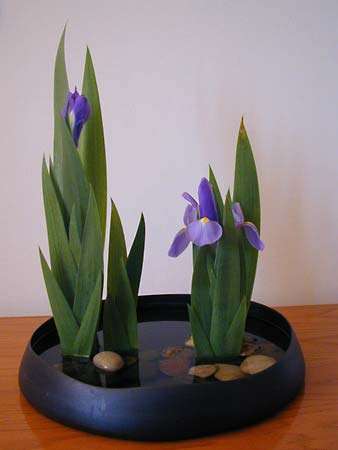
Ikebana Flower Display
by Marc Gilson
Director of Client Services, Centerpointe Research Institute
In the early 1950s, my grandfather, grandmother, and their two children (later to become my mom and uncle), relocated to Japan to live as missionaries for five years.
For many Americans like them, it was their first real exposure to Japanese culture, and while the country and its people were still occupied with the post-World War II rebuilding efforts, Japan’s ancient culture remained very much intact when my family members moved there.
My grandfather was especially charmed by Japanese art, history, and culture.
He loved to visit the museums, attend various ceremonies and performances, and sample the delicious Japanese cuisine.
And he fell in love with the scenery and people of the place, as attested by the thousands of snapshots he took of everyone and everything in Japan.
My grandfather was particularly transfixed by Ikebana, the remarkable Japanese art of flower arrangement.
Ikebana: The Way of the Flowers
Ikebana, sometimes called “Kado,” is one of three classical Japanese arts of refinement, including “Kado” (the way of the fragrance) for incense appreciation, and “Chado” for the famous tea ceremony.
If you’ve ever seen Ikebana floral displays you can probably see why my grandfather was so captivated by them. Ikebana is not just a bunch of pretty flowers placed in a vase. Ikebana aims at nothing less than to unite nature and humanity.
Line, shape, balance, position, and form are deeply considered aspects, as is the space between blossoms, leaves, and stems.
In fact, space in particular plays a crucial role in an Ikebana arrangement. The height and width of each floral element are essential factors, as are the colors and choice of base or vase within which the display sits.

In short, there is no aspect of an Ikebana display that happens as an accident.
Dozens of careful and deliberate choices are made to produce a work of Ikebana art. Ikebana artists practice under the tutelage of masters for years in order to perfect their craft.
A couple of years ago, I happened to come across some of my grandfather’s old books, including several books about Ikebana he had purchased while living in Japan.
Coincidentally, perhaps, at about that same time I learned of a local exhibition of Ikebana coming to my city.
I knew I had to go and see Ikebana for myself and try to understand why my grandfather had been so entranced by it.
The semi-enclosed room in which the exhibition was held was a place of perfect tranquil beauty.
As meditative traditional Koto music played quietly, an air of gentle reverence permeated the room.
Each arrangement was afforded its own space on tables covered in pure white linen.
Visitors slowly wandered from display to display, with obvious appreciation and wonder at these one-of-a-kind floral works of art made by masters of the craft.
What struck me most was how these deceptively simple-looking displays conveyed such serenity and introspection.
Moreover, when I examined the note card attached to each piece, I found that the descriptive name assigned by the artist almost magically fit my emotional response to the piece.
One display called, “Song in the Night,” created a lonely but hopeful feeling for me; a feeling I had even before reading the card.
Another called “Anchored Attention” definitely demanded nothing less than a kind of Zen-like focus and I noticed other visitors like me unwittingly lingering before it, our attentions duly anchored and affixed.
Among the forty or so displays I saw that day, the most unforgettable one for me was a tall, angular display with lots of long green bamboo leaves reaching upward–like straining, upstretched arms – from a simple square base of jet black stones. It was called “Aspiration.”
And while it was not as colorful or complex as many of the other arrangements, something about its simple beauty really touched my soul.

The Power of Space
I was struck, again and again, not only by the variety of exotic flowers, stems, containers, and leaves, but by the use of empty space within and around each display.
The space, as much as the floral and stone objects, were crucial to the effect the artist created for the viewer. And this reminded me of a lesson I’ve needed to relearn many times in life:
The empty space is at least as important as that which occupies it.
It seems to me that life is often overfilled with things, objects, people, even feelings and experiences that are not always welcome.
In fact, we sometimes seek out things to fill the space in our lives. When things get too quiet, we switch on the TV.
Even when we have a few moments to ourselves we habitually check our phones for the latest news or Facebook updates.
We fill our downtime with numerous distractions to feed the ever-hungry mind with something (anything!) to do.
It’s as though we fear silence, space, emptiness. We’re space-phobic, anti-quiet, and averse to stillness.
As a longtime coach at Centerpointe, I know that the main challenge faced by would-be meditators is boredom.
The simplest thing a human being can do is to just sit quietly for a few minutes, isn’t it?
Yet when we just sit with ourselves in a place of stillness and quiet, we almost immediately grow restless. There are, after all, so many other things we could or should be doing with our time!
When we manage to carve out a space for a little mental health break, we often regret the decision and find ourselves embroiled in a terrible internal battle against that sensory aficionado extraordinaire: the mind.

The Uncontrolled Mind
The mind knows our weakness, and exploits it with terrifying ease. It needs stimulus! Excitement! Distraction! Diversion!
The uncontrolled mind is an addict. It thinks it needs more of what it already has too much of. It seeks to cram the space we try to make with ideas, fantasies, worries, and plans. It tries to occupy the silence with noise and commotion.
It is desperate to remind us that “there are things to do!” “TV shows to watch!” “Games to play!” “People to deal with!” “Dishes to wash!” “Laundry to fold!” We live in an “anti-quiet culture” and the stress is killing us.
(This is where I could insert dozens of statistics and overwhelming scientific data to prove that stress is a very real danger and not all in your head. I’ll spare you that because you surely already know it.)
But suffice to say, stress is no joke. It’s very real. And it’s a killer.
As I write, it’s April 2019. And April is Stress Awareness Month. We all experience it – stress – in our own ways. And too often we try to combat it by adding something more to the mix.
More entertainment, more drink, more drugs, more talk, more food, more work, more distraction, something to just occupy and fill up enough of that open space to keep us busy.

The Stillness & The Emptiness
And yet we have over 4,000 years of accumulated wisdom, knowledge, and instruction spread among a dozen religions and spiritual systems that remind us that we should not fear that open space.
The very space we’re so busy filling up is the space where the real wisdom resides where centeredness, peace, and enlightenment is ours, if we could only learn to appreciate and value it.
That emptiness, as scary as it can be, is where all the secrets of self-awareness, and peace reside.
What we seek can be found in the stillness and emptiness, and is just waiting for us to slow down enough to notice it.
I left the Ikebana exhibition feeling changed, if even for a few moments by – of all things - floral displays.
Obviously, creating such beautiful pieces is not easy.
And while I never met the artists responsible for them, they had succeeded in providing me with a sense of connection to nature and the world around me through color, form, shape, and space.
I have to believe that my grandfather, an incredibly wise and self-reflective man, shared this same ineffable experience through these floral arrangements.
This is why he was so taken with Ikebana. And this realization brought me closer to him than ever before.
And the only lingering questions for me, and perhaps for you too, are:
- Can we make our peace with the open space?
- Can we be “at one” with emptiness?
- Can we find something of beauty and connection in the openness of each moment and the potential that space holds for us?
About Centerpointe

Centerpointe Research Institute was founded in 1989 by Bill Harris (1950-2018). The Institute produces as it's flagship a product called 'Holosync®,' an audio program formulated to recreate the brain wave patterns of experienced meditators.
If you use this program daily, you can achieve the same results in 8 times the time it takes for traditional meditation.
If you would like to get a free e-book called 'The New Science Of Super Awareness' by Bill Harris, please visit this web site.
When you sign up, you will also be able to get the audiobook version for free, as well as a free demo of Holosync®.
